Saturday, 16 June 2012: Special: Donald's grave
Written 1 July 2012
Through La Table Française,"a French-speaking club in Tallahassee, I came to know Audrey Robertson Wilson. She was born and raised in England, served in the military as a German-language radio listener during WWII, married an American after the war, and moved to Tallahassee. Widowed young, she went back to school, earned a doctorate in the humanities, and worked at Florida State for decades to support her three sons. By the time I first knew her, she had retired and was already rather frail.
In 2011, she published her memoirs, under the title England and Another Shore, which I (and my entire book club) immediately read, of course. In that book, she made frequent mention of her cousin Donald, to whom she was very close and who died in Normandy, in August of 1944, at age 25, and was buried in a Commonwealth military cemetery near Caen. A friend had once photographed his grave for her, but she had never had the chance to visit it.
Because we would be in Caen on this trip, I offered to photograph it again. Unfortunately, Audrey died in March 2012, just a couple of months before our trip, but I hope the photos I show here will be of interest to her family.
Once I learned Donald's last name from Audrey, I was able to look him up on the Commonwealth Graves Commission website: Donald George Robert Harvey, Lieutenant, 288055, Royal Engineers. His grave was listed as at location III. C. 2., Banneville-la-Campagne War Cemetery. The village of Banneville-la-Campagne is about 10 km east of Caen. The cemetery is on the main road (D675, "route de Caen") between Caen and Troarn, about 8 kilometres east of Caen.
To see the layout of the cemetery, Google "banneville cemetery france" (without quotes) or go straight to http://www.cwgc.org/find-a-cemetery/cemetery/2101000/BANNEVILLE-LA-CAMPAGNE%20WAR%20CEMETERY. When you click on "Location at Google Maps," you'll see both a photo and a map. We parked where the red car is in the photo, and when we were there, the plowed field was full of ripening grain. If you click for "Satellite" view, you can actually zoom in far enough to pick out individual gravestones.
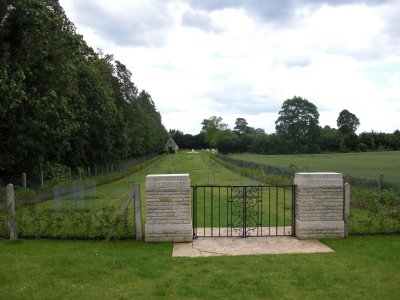
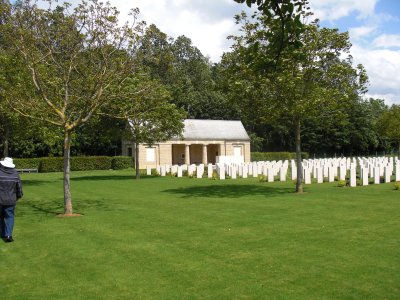 The axis of the cemetery runs (north)east to (south)west. From the tiny three-car parking area (just a lay-by on the edge of the road), this is what you see— a gate and a broad grassy avenue lined with newly planted trees (certainly replacements for older ones. In the distance are the gable end of a small stone building and a end of a white stone monolith, both shown below.
The axis of the cemetery runs (north)east to (south)west. From the tiny three-car parking area (just a lay-by on the edge of the road), this is what you see— a gate and a broad grassy avenue lined with newly planted trees (certainly replacements for older ones. In the distance are the gable end of a small stone building and a end of a white stone monolith, both shown below.
The building, the front of which is shown at the right faces the broad side of the monolith, then beyond that three long rectangular groups of graves, stretching away to the west, and finally at the far end, a tall cross (set in a semicircular recess in the boundary wall, easily seen on the aerial photo).
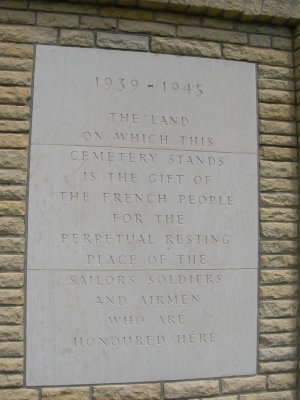
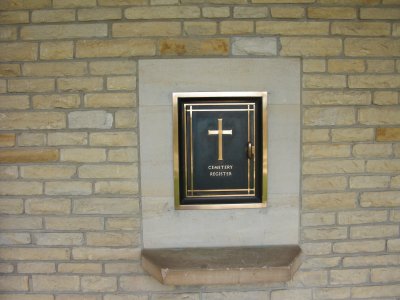 On the front of the building, in French on one side and in English on the other, is this plaque, reading "1939–1945. The land on which this cemetery stands is the free gift of the French people for the perpetual resting place of the sailors, soldiers, and airmen who are honoured here."
On the front of the building, in French on one side and in English on the other, is this plaque, reading "1939–1945. The land on which this cemetery stands is the free gift of the French people for the perpetual resting place of the sailors, soldiers, and airmen who are honoured here."
In the center, under the little pillared portico, is this small vault, airtight but unlocked, containing the cemetery register, on which you can look up the location of any of the graves by name, and a guest book and pen. I left a short explanation of the reason for our visit and my sorrow that Audrey would not get to see the photos.
Every Commonwealth war cemetery includes a monolith like the one shown below (facing the stone building), engraved with the words chosen by Rudyard Kipling when he was head of the Commonwealth War Graves Commission after WWI, "Their name liveth for evermore." Kipling's son Jack died at Ypres, in Belgium, during WWI, and his body was never found.
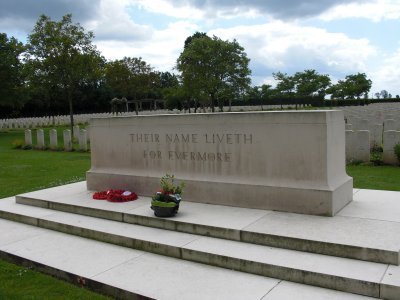
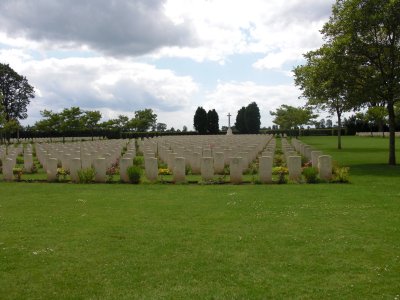 Beyond the monolith are the graves themselves and, at the far end, the stone cross. Here, you can see most of the center section of graves, plus, in the distance, a little of the lefthand section and a little of the righthand section.
Beyond the monolith are the graves themselves and, at the far end, the stone cross. Here, you can see most of the center section of graves, plus, in the distance, a little of the lefthand section and a little of the righthand section.
As you can see, like all Commonwealth war cemeteries we've seen, this one is profusely planted with flowers—a rose bush every two graves, and many other bedding plants in between. Although the American ones are beautifully landscaped, the areas containing graves include only gravestones and plain grass.
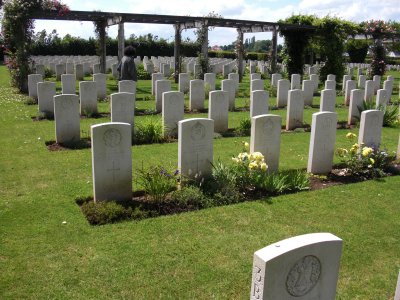
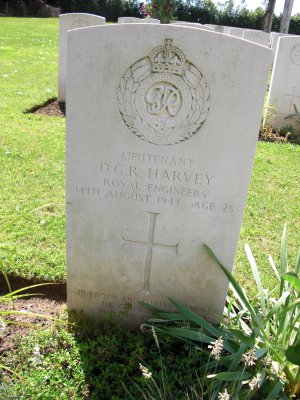 Donald's grave is in the lefthand (southern) section, the one at the bottom of the screen in the Google aerial view. In the photo at the left, you can see, on the edge of the stone at the lower right, "3B." The end stone in the row behind it, says "3C," corresponding to the "III c" of the location of Donald's grave. The stone to its right, i.e., the second from the end of the row, is Donald's, i.e., III c 2, between the cream-colored rose and the blue Tradescantia. It's the 13th row back from the "front" of the section (nearest the stone building) and, as you can see, the fourth row forward from the wooden arbor that transects the southern section. The arbor is clearly visible on the Google aerial photo, so you should be able to pinpoint the grave exactly in that view.
Donald's grave is in the lefthand (southern) section, the one at the bottom of the screen in the Google aerial view. In the photo at the left, you can see, on the edge of the stone at the lower right, "3B." The end stone in the row behind it, says "3C," corresponding to the "III c" of the location of Donald's grave. The stone to its right, i.e., the second from the end of the row, is Donald's, i.e., III c 2, between the cream-colored rose and the blue Tradescantia. It's the 13th row back from the "front" of the section (nearest the stone building) and, as you can see, the fourth row forward from the wooden arbor that transects the southern section. The arbor is clearly visible on the Google aerial photo, so you should be able to pinpoint the grave exactly in that view.
At the right is Donald's stone. The epitaph at the bottom, chosen, like all the others, by his family at the time, reads "In proud and loving memory. He gave his life for his country." This photo is a thumbnail view. To see the full-size photo, to examine the detail, just click on the one shown here.
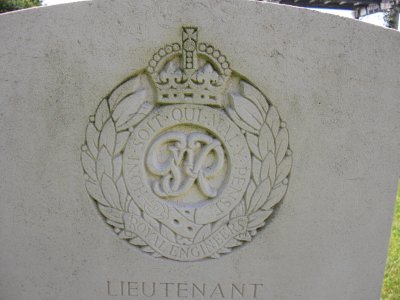
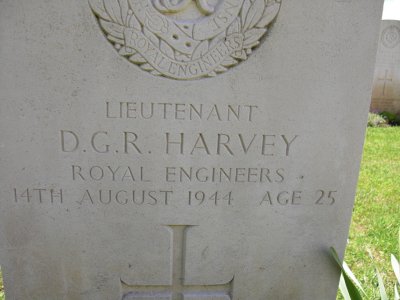 Here are closer views of the Royal Engineers insignia at the top of the stone (the motto reads "Honi soit qui mal y pense.") and the informational inscription giving the date and age of death.
Here are closer views of the Royal Engineers insignia at the top of the stone (the motto reads "Honi soit qui mal y pense.") and the informational inscription giving the date and age of death.
We read many of the names and inscriptions—David, CJ, and I were the only ones there, and we took our time. A particularly poignant one, on the grave of Seargeant R. Carr, Wireless Operator, Royal Air Force, who died on D-Day at age 21, reads "The world which credits what is done is cold to all that might have been."
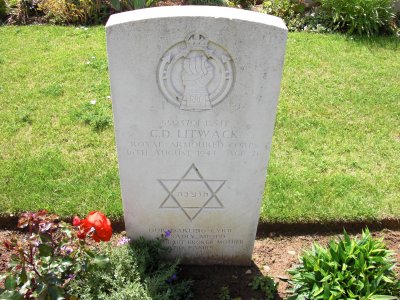
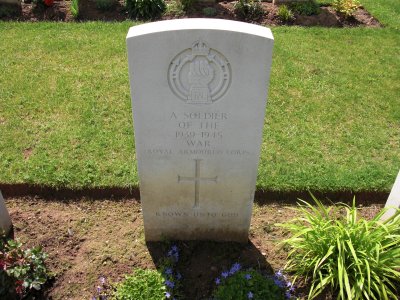 Commonwealth war cemeteries often include graves of other nationalities or even German ones, but this one seemed to be quite uniformly of British graves.
Commonwealth war cemeteries often include graves of other nationalities or even German ones, but this one seemed to be quite uniformly of British graves.
We found a few stones with stars of David rather than crosses, like the one at the left here, and quite a few of unknowns, like the one at the right, which reads "A soldier of the 1939-1945 war known unto God," but none of muslims or other faiths.
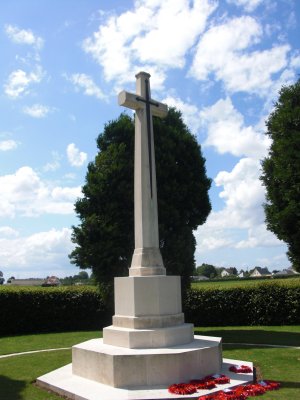
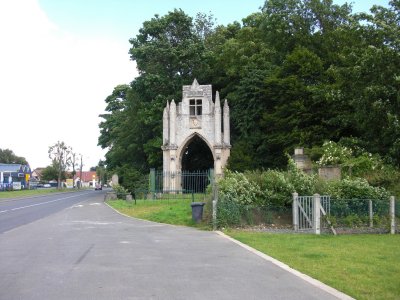 At the left is a nearer view of the cross at the far end of the cemetery, and at the right an isolated stone arch near the parking area (I think it's a propos of the adjoining estate and nothing to do with the cemetery, but it somehow seems a fitting landmark for the cemetery entrance).
At the left is a nearer view of the cross at the far end of the cemetery, and at the right an isolated stone arch near the parking area (I think it's a propos of the adjoining estate and nothing to do with the cemetery, but it somehow seems a fitting landmark for the cemetery entrance).
If you would like to see additional photos of the cemetery and the graves in it, please let me know (click "List of Entries," then "E-mail Anne").
previous entry
List of Entries
next entry

 The axis of the cemetery runs (north)east to (south)west. From the tiny three-car parking area (just a lay-by on the edge of the road), this is what you see— a gate and a broad grassy avenue lined with newly planted trees (certainly replacements for older ones. In the distance are the gable end of a small stone building and a end of a white stone monolith, both shown below.
The axis of the cemetery runs (north)east to (south)west. From the tiny three-car parking area (just a lay-by on the edge of the road), this is what you see— a gate and a broad grassy avenue lined with newly planted trees (certainly replacements for older ones. In the distance are the gable end of a small stone building and a end of a white stone monolith, both shown below.
 On the front of the building, in French on one side and in English on the other, is this plaque, reading "1939–1945. The land on which this cemetery stands is the free gift of the French people for the perpetual resting place of the sailors, soldiers, and airmen who are honoured here."
On the front of the building, in French on one side and in English on the other, is this plaque, reading "1939–1945. The land on which this cemetery stands is the free gift of the French people for the perpetual resting place of the sailors, soldiers, and airmen who are honoured here." 
 Beyond the monolith are the graves themselves and, at the far end, the stone cross. Here, you can see most of the center section of graves, plus, in the distance, a little of the lefthand section and a little of the righthand section.
Beyond the monolith are the graves themselves and, at the far end, the stone cross. Here, you can see most of the center section of graves, plus, in the distance, a little of the lefthand section and a little of the righthand section.



 Here are closer views of the Royal Engineers insignia at the top of the stone (the motto reads "Honi soit qui mal y pense.") and the informational inscription giving the date and age of death.
Here are closer views of the Royal Engineers insignia at the top of the stone (the motto reads "Honi soit qui mal y pense.") and the informational inscription giving the date and age of death.
 Commonwealth war cemeteries often include graves of other nationalities or even German ones, but this one seemed to be quite uniformly of British graves.
Commonwealth war cemeteries often include graves of other nationalities or even German ones, but this one seemed to be quite uniformly of British graves. 
 At the left is a nearer view of the cross at the far end of the cemetery, and at the right an isolated stone arch near the parking area (I think it's a propos of the adjoining estate and nothing to do with the cemetery, but it somehow seems a fitting landmark for the cemetery entrance).
At the left is a nearer view of the cross at the far end of the cemetery, and at the right an isolated stone arch near the parking area (I think it's a propos of the adjoining estate and nothing to do with the cemetery, but it somehow seems a fitting landmark for the cemetery entrance).